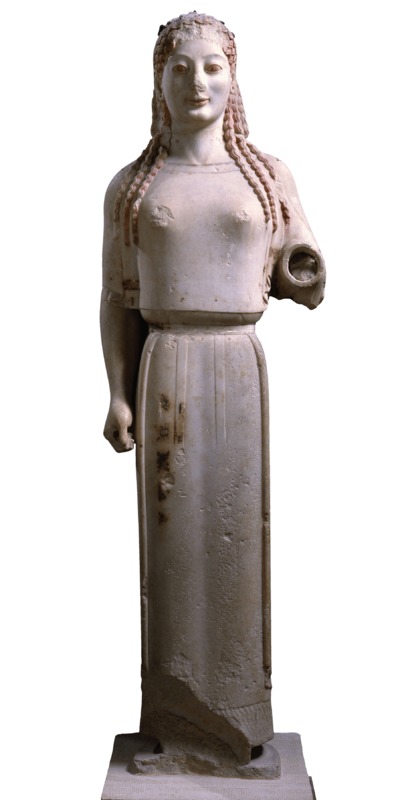Peplos Kore
Title
Peplos Kore
Date
530 BC (Archaic Greece)
Artist or Workshop
unknown
Materials
Parian marble with traces of paint
Height of the work
118 cm tall
Provenience
Greece, Athens, Athenian Acropolis, North-West of the Erechtheion
Current Location
The Acropolis Museum, Athens, Greece
Sitter Biography
The kore are representations of young women used to mark graves or used as votive offerings. The word Kore means 'young woman' or 'girl' in ancient Greek. The sitter in this work is unknown.
Description and Significance
Description:
Her dress is a garment called a peplos that covers her body from her shoulders to her feet. Her garment is belted. She has an underdress called a chiton peeking out from under the sleeves and hem.
The lower half of her body is column-like. From her waist down her skirt encloses her legs and feet. Her torso is front facing and her posture is upright. She is holding out her left arm, which is bent at the elbow. The forearm and hand are missing, but are presumed to of held an attribute. In many reconstructions, it is sown being held straight out with the palm upright. Her right arm is down to her side and clenched in a loose fist. While the body of the statue is common and seen across many other Kore, she has other distinguishing features. Her hair is very detailed and styled. She features traces of paint that tell us that she was painted originally, giving the opportunity to individualize her garment. Her face features relaxed but alert eyes with an archaic smile. Traces of paint have been found on the statue, indicating that the dress was painted, as well as the hair and parts of the face.
Significance:
The statue is carved in the round but is meant to be seen from the front. Kore were often put on pedestals so one would be looking slightly up at the statue. It has been noticed by scholars that there are some holes in the statue. There are some around the head, presumed to have held a metal wreath, as well as some on the preserved hand and on the base of the statue, presumed to be for a metal weapon or shield. The hole in the hand went through the hand. The holes were squarelike in shape. As well as holes in the shoulders, possibly for metal dress-fasteners.
The jury is out on who is represented here. Some scholars believe that it is a "type" of grave marker. Others believe it is a goddess like Athena. Some scholars believe that it is an induvial representation of the deceased.
Her dress is a garment called a peplos that covers her body from her shoulders to her feet. Her garment is belted. She has an underdress called a chiton peeking out from under the sleeves and hem.
The lower half of her body is column-like. From her waist down her skirt encloses her legs and feet. Her torso is front facing and her posture is upright. She is holding out her left arm, which is bent at the elbow. The forearm and hand are missing, but are presumed to of held an attribute. In many reconstructions, it is sown being held straight out with the palm upright. Her right arm is down to her side and clenched in a loose fist. While the body of the statue is common and seen across many other Kore, she has other distinguishing features. Her hair is very detailed and styled. She features traces of paint that tell us that she was painted originally, giving the opportunity to individualize her garment. Her face features relaxed but alert eyes with an archaic smile. Traces of paint have been found on the statue, indicating that the dress was painted, as well as the hair and parts of the face.
Significance:
The statue is carved in the round but is meant to be seen from the front. Kore were often put on pedestals so one would be looking slightly up at the statue. It has been noticed by scholars that there are some holes in the statue. There are some around the head, presumed to have held a metal wreath, as well as some on the preserved hand and on the base of the statue, presumed to be for a metal weapon or shield. The hole in the hand went through the hand. The holes were squarelike in shape. As well as holes in the shoulders, possibly for metal dress-fasteners.
The jury is out on who is represented here. Some scholars believe that it is a "type" of grave marker. Others believe it is a goddess like Athena. Some scholars believe that it is an induvial representation of the deceased.
References
Cook, R. M. “The Peplos Kore and Its Dress.” The Journal of the Walters Art Gallery, vol. 37, 1978, pp. 84–87. JSTOR, JSTOR, www.jstor.org/stable/20168963.
Ridgway, Brunilde Sismondo. “The Peplos Kore, Akropolis 679.” The Journal of the Walters Art Gallery, vol. 36, 1977, pp. 49–61. JSTOR, JSTOR, www.jstor.org/stable/20168947.
Ridgway, Brunilde Sismondo. “The Peplos Kore, Akropolis 679.” The Journal of the Walters Art Gallery, vol. 36, 1977, pp. 49–61. JSTOR, JSTOR, www.jstor.org/stable/20168947.
Contributor
Anna Nielsen
Citation
unknown, “Peplos Kore,” Digital Portrait "Basket" - ARTH488A - "Ancient Mediterranean Portraiture", accessed May 14, 2025, https://classicalchopped2.artinterp.org/omeka/items/show/23.
Item Relations
This item has no relations.

